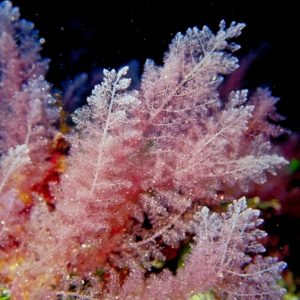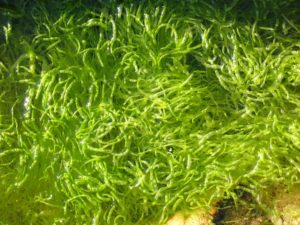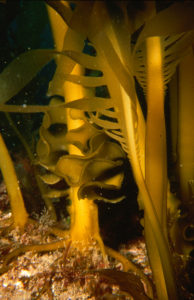
The Secrets of Seaweed
Why is seaweed remarkable? After all, it’s just a vegetable that grows in the ocean and places like rivers, lakes, and other bodies of water. It’s common, including countless species of marine plants and algae. Many types exist, classified as red (Rhodophyta), green (Chlorophyta), and brown (Phaeophyta) algae. Typical types of edible seaweeds include Wakame, Dulse, Kombu, Kelp, Sea lettuce, Arame, and Chlorella.
Yet seaweed could be a revolution “to transform our world.” According to Vincent Doumeizel’s recent book, The Seaweed Revolution, it “could help to bring back balance in our ecosystems through a wide range of applications. It could allow us to better feed human beings and animals, replace plastic and fertilizers, boost medical innovations, mitigate global warming, repair biodiversity, and support economies in coastal communities where fish stocks are declining.”
The ocean covers 71% of Earth’s surface but contributes only about 5% of the human diet, according to the Consumer Goods Forum. Yet the World Wildlife Fund reports that seaweed production has grown to over 35 million tons, more than doubling in the last decade.
Seaweed has stipes (stalks or stems), holdfasts (clamps that anchor it to a surface), and blades or fronds (the surfaces that absorb sunlight). These parts allow for photosynthesis, the process by which green plants and some other organisms use sunlight to synthesize foods from carbon dioxide and water.
Its farming presents enormous benefits:
-

Red seaweed in Fiji (Photo: Derek Keats, CC BY 2.0, via Wikimedia Commons)
Seaweed is rich in protein. The red variety in particular has a high content of protein (up to 47%) and essential amino acids, which help the human body maintain optimal health. In its natural habitat of salt water, “only 2% of the vast ocean space would be necessary to feed 12 billion people with sufficient protein, with no need for an additional plant based or animal protein.”
- Seaweed consumption produces health benefits. An overview of the benefits declares that common types “possess a low lipid [fatty compound] content, nonetheless enriched in polyunsaturated fatty acids. This characteristic makes them even more attractive, as they are a healthy, nutritive and low-caloric food.” What’s more, seaweed is “identified as ‘nutraceutical food,’ a food that provides not only nutritional value but also may help to prevent health problems. Seaweed-based foods are considered nutraceutical products due to the positive effects on human health, for example, to alleviate arthritis, diabetes, autoimmune, ocular and cardiovascular diseases.”
- Seaweed has the natural ability to absorb harmful greenhouse gas (GHG) emissions. Like other photosynthesizers, it absorbs carbon dioxide as it grows, transforming it into biomass, renewable organic material that comes from plants and animals. According to the Consumer Goods Forum, 30% of GHG emissions are absorbed by seaweed. What’s more, recent studies have found that feeding asparagopsis seaweed (edible red macroalgae) to cows can cut methane emissions; feeding red algae to meat animals daily can reduce their methane emissions by 90-99%. To put that into context, that’s the “equivalent to stopping every car on the planet overnight in terms of comparable GHG emissions.”
-

Green seaweed Ulva intestinalis (Photo: Vilseskogen, CC BY-NC 2.0 DEED)
Seaweed is the only vegetable grown in salt water yet it can remove salts and minerals from the water in a natural desalination process. “Fresh water can be produced from seaweed when it is squeezed, thereby making it a valuable source of drinking water, juice or irrigation for those areas of our planet affected by drought.”
- Seaweed also has the high capacity to accumulate heavy metals in its tissues. Research has found it can absorb copper, cobalt, nickel, lead, and zinc from wastewater effectively. Nutrients such as ammonia, nitrate, phosphorus, and nitrogen, which are found in agricultural run-off and industrial and sewage water discharge, can all be absorbed by seaweed. This means that farming it in areas where these discharges occur could be used as an environmentally friendly tool to help improve water quality.
- Seaweed grows fast. An article in TIME magazine states that it “does not require fresh water or fertilizers and grows at a much faster rate than trees, expanding by up to two feet [~61 cm] a day.” It’s thus a good renewable resource that can be made into biodegradable and even edible packaging. It can be composted and will break down in 4-6 weeks, unlike conventional plastic that can “survive as litter for thousands of years,” as reported by Scientific American.
- Seaweed is also used in cosmetics such as creams, soaps, shampoos, and toothpaste. Its various nutrients in products have cleansing and detoxing properties, can improve skin tone and pigmentation, increase hydration, help smooth out wrinkles, and provide vitamins, minerals, and nutrients to the skin, while being 100% natural and safe to use.
- Seaweed has been used for medicinal purposes for millennia, including in traditional Chinese medicine for approximately 2,000 years to treat a number of disorders, such as thyroid disease. The ancient Romans used it to treat wounds and burns. Because of its high dietary fiber content, as a food source it could help prevent cardiovascular diseases. Seaweed fiber has also been shown in several clinical studies to facilitate weight loss by enhancing the feeling of satiety. And its rich nutrient content makes it a versatile treatment for respiratory ailments, arthritis, colds, and influenza. Seaweed baths relieve muscle and joint pain, as well as eczema, and reduce swelling.
As summarized by the World Wildlife Fund, “Seaweed is easy to grow, versatile, and beneficial to ocean ecosystems. Farming seaweed is an efficient way to produce highly nutritious food for a growing population. Unlike terrestrial crops, seaweed doesn’t require fertilizer, pesticides, freshwater, or land, and it grows rapidly—some marine algae can be ready to harvest in as little as six weeks. It acts as an underwater forest that absorbs carbon, nitrogen, and phosphorus, making it a valuable tool to fight climate change and a water purifier, while also creating new habitat for a diversity of marine life.”


